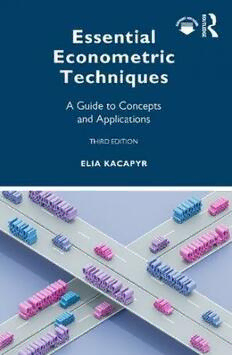Table Of Content
Voices on the second edition
“Professor Kacapyr’s work in the field of econometrics—
specifically, his work in making the subject more understandable
to aspiring economics students and enthusiasts—is incredible. His
style is straightforward and engaging, delivering the subject matter
so effortlessly that it is a pleasure to read and immerse yourself in
the text.”
—Krasimir Kehayov, Goldman Sachs
“Direct and to the point, Professor Kacapyr provides an
effective exposition of the essentials of econometrics in both
technical terms and prose. The second edition [...] is a rugged
and reliable resource for instructor, learner, and practitioner.
Kacapyr targets economics majors, but this book is also suited
for use in courses in business, statistics, and social sciences,
where the same skills are applied.”
—Wade L. Thomas, SUNY Oneonta
“I really like this book as a supplement to the required text in
my course. It’s at the exact level that my students need, and the
exercises are great practice for them.”
—Cynthia Bansak, St. Lawrence University
Essential Econometric Techniques
Now in its third edition, Essential Econometric Techniques: A Guide to
Concepts and Applications is a concise, student-friendly textbook which
provides an introductory grounding in econometrics, with an emphasis
on the proper application and interpretation of results.
Drawing on the author’s extensive teaching experience, this book
offers intuitive explanations of concepts such as heteroskedasticity and
serial correlation, and provides step-by-step overviews of each key topic.
This new edition contains more applications, brings in new material
including a dedicated chapter on panel data techniques, and moves the
theoretical proofs to appendices. After Chapter 7, students will be able to
design and conduct rudimentary econometric research. The next chapters
cover multicollinearity, heteroskedasticity, and autocorrelation, followed
by techniques for time-series analysis and panel data.
Excel data sets for the end-of-chapter problems are available as a
digital supplement. A solutions manual is also available for instructors,
as well as PowerPoint slides for each chapter.
Essential Econometric Techniques shows students how economic
hypotheses can be questioned and tested using real-world data, and is
the ideal supplementary text for all introductory econometrics courses.
Elia Kacapyr is Professor of Economics at Ithaca College, USA.
Essential Econometric
Techniques
A Guide to Concepts and
Applications
Third Edition
Elia Kacapyr
Cover image: © Jorg Greuel/Getty Images
Third edition published 2022
by Routledge
605 Third Avenue, New York, NY 10158
and by Routledge
4 Park Square, Milton Park, Abingdon, Oxon, OX14 4RN
Routledge is an imprint of the Taylor & Francis Group, an informa business
© 2022 Elia Kacapyr
The right of Elia Kacapyr to be identified as author of this work has been asserted in
accordance with sections 77 and 78 of the Copyright, Designs and Patents Act 1988.
All rights reserved. No part of this book may be reprinted or reproduced or utilised in any
form or by any electronic, mechanical, or other means, now known or hereafter invented,
including photocopying and recording, or in any information storage or retrieval system,
without permission in writing from the publishers.
Trademark notice: Product or corporate names may be trademarks or registered trademarks,
and are used only for identification and explanation without intent to infringe.
First edition published by M.E. Sharpe Inc 2011
Second edition published by Routledge 2015
Library of Congress Cataloging-in-Publication Data
A catalog record has been requested for this book
ISBN: 978-1-032-10122-4 (hbk)
ISBN: 978-1-032-10121-7 (pbk)
ISBN: 978-1-003-21375-8 (ebk)
DOI: 10.4324/9781003213758
Typeset in Sabon
by MPS Limited, Dehradun
Access the Support Material: www.routledge.com/9781032101217
Contents
1 The Nature of Econometrics 1
2 Simple Regression Analysis 12
3 Residual Statistics 30
4 Hypothesis Testing 39
5 Multivariate Regression 53
6 Alternate Functional Forms 77
7 Dichotomous Variables 98
8 The Classical Linear Regression Model 115
9 Multicollinearity 129
10 Heteroskedasticity 137
11 Serial Correlation 150
12 Time-Series Techniques 166
13 Panel Data Techniques 192
Critical Values Tables 207
Cited Works 211
Index 213
The Nature of
1
Econometrics
WHAT IS ECONOMETRICS?
Literally, econometrics means “economic measurement.” Therefore,
gathering data and generating economic statistics such as gross domestic
product and the consumer price index could be considered econo-
metrics. In practice econometrics is about testing economic hypotheses
with statistical techniques. Respected econometricians have given us a
variety of definitions. One favorite, perhaps because of its brevity, is
from Henri Theil: “Econometrics is concerned with the empirical de-
termination of economic laws” (Theil 1971, p. 1).
Economics is comprised of innumerable laws, theories, hypotheses,
assumptions, and suppositions. Econometrics is subjecting any of these
to empirical verification. Empirical means “by observation or experi-
ence.” Rather than argumentation or debate, econometrics is about
testing economic ideas to see if they hold true.
Students may say that econometrics is like a mash-up of their statistics
course with an economics course. That is not a bad description of an
econometrics class; only it conceals the main point—econometrics is
about testing a proposition of some sort.
Data mining is a field similar to econometrics. The difference is that
data miners say, “Let’s see what the data reveal about this idea.”
Econometricians say, “Let’s get the data and test if this idea holds true.”
This may seem like a trifling difference, but it turns out to be important.
Data miners comb the data for interesting relationships. Econometricians
use the data to test if a specific idea can be rejected or not.
DOI: 10.4324/9781003213758-1

